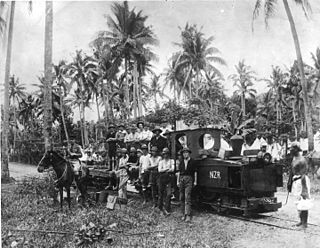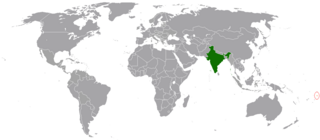
The Samoan Islands were first settled some 3,500 years ago as part of the Austronesian expansion. Both Samoa's early history and its more recent history are strongly connected to the histories of Tonga and Fiji, nearby islands with which Samoa has long had genealogical links as well as shared cultural traditions.

Apia is the capital and only city of Samoa. It is located on the central north coast of Upolu, Samoa's second-largest island. Apia falls within the political district (itūmālō) of Tuamasaga.
The turbulent decades of the late 19th century saw several conflicts between rival Samoan factions in the Samoan Islands of the South Pacific. The political struggle lasted roughly between 1886 and 1894, primarily between Samoans contesting whether Malietoa Laupepa, Mata'afa Iosefo, or a member of the Tupua Tamasese dynasty would be King of Samoa. While largely a political struggle, there were also armed skirmishes between the factions. The military of the German Empire intervened on several occasions. A naval standoff between the United States, Germany, and the United Kingdom ensued.

The Second Samoan Civil War was a conflict that reached a head in 1898 when Germany, the United Kingdom, and the United States were locked in dispute over who should have control over the Samoan island chain, located in the South Pacific Ocean.
The Apia Samoa Temple was the 24th constructed and 22nd operating temple of the Church of Jesus Christ of Latter-day Saints. It was the first built in Samoa and the third to be built in Polynesia. After it was destroyed by fire, a new temple was built and dedicated on the same grounds.

Rugby union in Samoa is the country's most popular sport. The national teams in both the standard 15-man game and rugby sevens are consistently competitive against teams from vastly more populous nations.

Faleolo International Airport is an airport located 40 kilometres (25 mi) west of Apia, the capital of Samoa. Until 1984, Faleolo could not accommodate jets larger than a Boeing 737. Services to the United States, Australia, or New Zealand, could only land at Pago Pago International Airport in American Samoa. Since the airport's expansion, most international traffic now uses Faleolo.
The 2007 Pacific Games men's football tournament was held at the Toleafoa J.S. Blatter Complex in Apia, Samoa in from 25 August to 7 September 2007.

The 2007 South Pacific Games were held in Apia, Samoa, from 25 August to 8 September 2007. The Games were the thirteenth to be held since the inception of the South Pacific Games in 1963, and included traditional multi-sport event disciplines, such as athletics and swimming, alongside region-specific and smaller events such as outrigger canoeing, surfing and lawn bowls.

The Occupation of Samoa was the takeover – and subsequent administration – of the Pacific colony of German Samoa by New Zealand during World War I. It started in late August 1914 with landings by the Samoa Expeditionary Force from New Zealand. The landings were unopposed and the New Zealanders took possession of Samoa for the New Zealand Government on behalf of King George V. The Samoa Expeditionary Force remained in the country until 1915, while its commander, Colonel Robert Logan, continued to administer Samoa on behalf of the New Zealand Government until 1919. The takeover of Samoa was New Zealand's first military action in World War I.

The Catholic Church in Samoa is part of the worldwide Catholic Church, which, initiated by the life, death and resurrection of Jesus Christ, and under the spiritual leadership of the Pope and Roman curia in the Vatican City is the largest Christian church in the world. Catholic missionaries arrived in Samoa in 1845 and today Catholics account for around 20% of the overall population. Archbishop Alapati Lui Mataeliga was ordained as head of the Archdiocese of Samoa-Apia in 2003.

The Samoa Expeditionary Force (SEF) was a small volunteer force of approximately 1,400 men raised in New Zealand shortly after the outbreak of World War I to seize and destroy the German wireless station in German Samoa in the south-west Pacific. Britain required the German wireless installations to be destroyed because they were used by Vizeadmiral Maximilian von Spee's East Asia Squadron of the Imperial German Navy, which threatened merchant shipping in the region. Following the capture of German possessions in the region, the SEF provided occupation forces for the duration of the war. Australia provided a similar force for the occupation of German New Guinea.

Mata'afa Iosefo was a Paramount Chief of Samoa who was one of the three rival candidates for the kingship of Samoa during colonialism. He was also referred to as Tupua Malietoa To'oa Mata'afa Iosefo. He was crowned the King of Samoa on 15 November 1898.

The Samoan crisis was a standoff between the United States, the German Empire, and the British Empire from 1887 to 1889 over control of the Samoan Islands during the First Samoan Civil War.

The SecondBattle of Vailele was fought during the Second Samoan Civil War in 1899. British, American and Samoan forces loyal to Prince Tanu were defeated by a superior force of Samoan rebels loyal to Mata'afa Iosefo. Fighting occurred at the former German plantation of Vailele, Samoa and was a major engagement in the small colonial conflict.

The siege of Apia, or the battle of Apia, occurred during the Second Samoan Civil War in March 1899 at Apia. Samoan forces loyal to Malietoa Tanumafili I were besieged by a larger force of Samoan rebels loyal to Mata'afa Iosefo. Supporting Malietoa were landing parties from four British and American warships. Over the course of several days of fighting, the Samoan rebels were defeated.

Western Samoa Mandate, then Western Samoa Trust Territory, officially Territory of Western Samoa was the name of Western Samoa during its civil administration by New Zealand between 1920 and Samoan independence in 1962. Six years earlier, German Samoa was captured by New Zealand forces shortly after the outbreak of World War I, but it would not be formally annexed by the British Empire until then.

Moata'a is a Samoan football club based in Apia. It plays in the Samoa National League.
The First Battle of Vailele occurred on 18 December 1888 at the German plantation of Vailele as part of the First Samoan Civil War. About 150 sailors from SMS Olga, SMS Eber and SMS Adler landed 80 marines near Apia to confront the Mata'afas rebels while the rest sailed along the coast on longboats. The Germans expected Government troops from Tamasese to reinforce them, however none had come. In the ensuing fighting, the Germans lost 16 marines and sailors in battle and 40 wounded; at least 14 died from their wounds, other sources claim that 30 were killed in total aswell as the 40 wounded. almost 70% of their force. They fled to the coast where they were rescued by the longboats. Soon after German plantations and property in Vailele were all plundered and burnt down.

India–Samoa relations are the international relations that exist between India and Samoa. The High Commission of India in Wellington, New Zealand, is concurrently accredited to Samoa. Samoa maintains an Honorary Consul in New Delhi.















